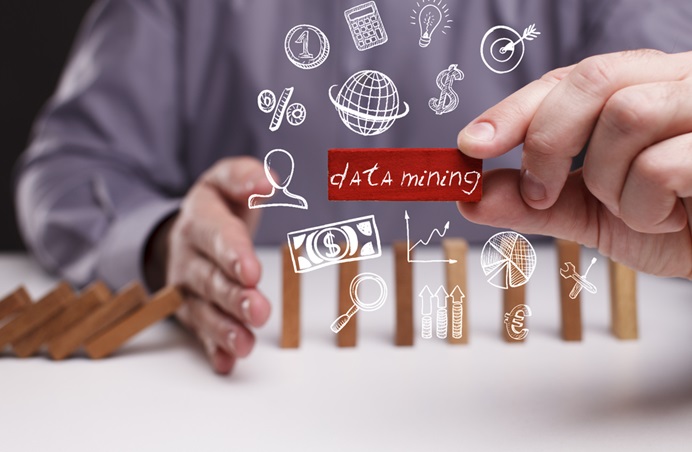Data mining guide implementation
Data mining is the process of searching and discovering information that stands out in a large amount of data. It includes recognizing patterns and trends, and structuring the raw data to crystallize useful information.
Data mining plays a crucial role in many fields of human activity. It works through such areas as machine learning, NNs, and statistics.
What are data mining techniques?
The amount of information is growing every year, if not every day. Navigating this ocean of data is becoming increasingly difficult. Here data mining comes in.
The mining process works in 3 stages: search, analysis, and interpretation of information for its intended purpose. So we can decrease the informational noise. Mining also allows you to structure the information you are looking for much faster.
Due to automation, mining allows you to collect and analyze data based on algorithms. Typical examples of mining are weather forecasts made with the help of technology, artifacts in scientific research, personalization of customer experience, etc.
Types of data mining
There are two types of data mining: predictive and descriptive. Each type tries to solve specific tasks.
Let’s consider each type in more detail.
Predictive data mining
Predictive data mining works with row data, evaluating the consistency of the collected figures, recognizing the anomalies, which can significantly alter the model results.
There are 4 types of predictive analytics:
Classification Analysis — often used to work with metadata. Allows you to group information into classes and thereby create algorithms. Email and similar services, where spam, viruses, and prohibited content pieces are detected, are work based on the classification analysis.
Regression Analysis — as in statistics, regression analysis in data mining reveals the relationship between two or more variables and the specifics of this relationship (dependent and independent variables). Regression analysis helps to make predictive analytics and forecasts as well.
Time Serious Analysis — uses data points at specific time intervals (hour, month, year, etc.). In business, this type of mining helps to create reports, measure the performance and profitability of processes, evaluate the activities of employees and work with clients. The opportunities of this type are great, but not all companies use it to the fullest.
Prediction Analysis — is used to identify the correlation between independent variables and predict their correlation in the future. A typical example is making a forecast of profits depending on the sales in a certain period. Identification of the relationship between the dependent and the independent variable is also used. The main difference from regression analysis is the period (in the latter, a connection is in the past).
Descriptive mining
Descriptive data mining focuses on collecting and processing relevant information for further use, in particular, for predictive analytics. For example, it allows you to highlight issues in business operations, supply chains, customer pain points, etc.
There are 4 types of descriptive mining:
Clustering Analysis — usually confused with classification analysis. The key difference is that clustering is based on many similar data characteristics (categories, scope, topics) while classification is based on one larger indicator (purpose of use, industry, date of creation, etc.). Thus, clusters are a more specific grouping of data, while classification is more global. Each category created by classification analysis can contain many clusters, but not vice versa.
Summarization Analysis — is designed to store a set of data in a laconic and understandable form. It can be graphs or charts.
Association Rules Analysis — used to identify hidden patterns between two or more variables in big data. It also allows you to model correlations and detect matches between variables. Association Rules Analysis is often used by retailers to understand customers’ and users’ behaviour. It includes their shopping carts, product personalization, and other settings. Another important application of data mining is the development of software based on machine learning in the IT industry.
Sequence Discovery Analysis — is a method similar to Time Serious Analysis. However, it does not use numerical values in a specific order but discrete data (or values), which can also be subjective. It may contain adjacent observations that also follow a particular order or frequency.
Other data mining techniques
In addition to the methods mentioned above, there’re several other key data mining processes.
Anomaly detection — allows you to identify irrelevant pieces of data or values. It may include previously unknown variables, ungrouped data or clusters, artifacts, perceptible deviations from average values, etc. A typical example of this type of mining is the banking system. With it, they can identify atypical activities that could potentially be fraudulent.
Exploratory data analysis (EDA) — works mainly with graphs and charts, i. e. with systematized data to identify current trends. In this case, all initial hypotheses are not taken into account, only the current moment is studied.
Decision trees — are a hierarchical data model created for decision making. The algorithm guides candidates (be it a person or a solution) through a specific set of questions or tasks, and at the end a corresponding solution is issued. Algorithms for online tests of various goals and levels work on such a system.
Conclusion
Data mining is designed to help companies and individuals to make their businesses more profitable and their efforts more cost-effective. Each type of mining allows you to solve a specific task or set of tasks. All you need is to understand them and start using or hiring competent AI experts to do it for you. Use all the opportunities of mining for personal and global progress.








